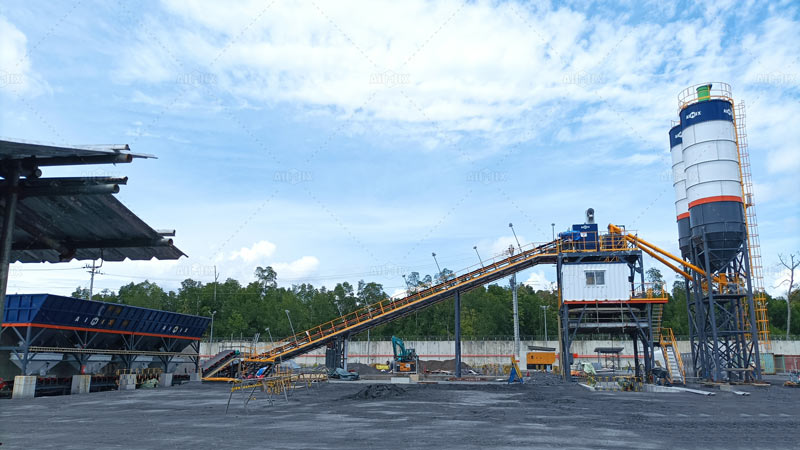In Latin America’s fast-growing construction sector, concrete plant operations are central to delivering consistent, high-quality concrete for roads, bridges, and infrastructure projects. Maintaining steady production requires timely replacement of wearing parts and smart maintenance practices. This article explains the typical replacement cycles, cost drivers, and practical maintenance strategies for both stationary and mobile concrete plant setups in the region.
Understanding the Role of Wearing Parts in Concrete Plants
A concrete plant(planta de concreto) is a mechanically intensive system where aggregates, cement, and water are mixed and moved continuously. Several components face heavy abrasion, impact, and fatigue, causing progressive wear. Common wearing parts include:
- Mixer blades and liners
- Aggregate conveyor belts and rollers
- Screw conveyors and bearings
- Weighing sensors, seals, and gaskets
- Valves, discharge gates, and chutes
The life of each part depends on feedstock abrasiveness, environmental conditions (humidity, dust), production volume, and maintenance discipline. For example, coarse or siliceous aggregates will accelerate wear on mixer internals. For mobile concrete plant units, frequent relocation and changing jobsite conditions typically increase mechanical stress and may shorten replacement cycles.
Replacement Cycles for Key Wearing Parts
Replacement intervals are best estimated using operating hours, production tonnage, and observed wear patterns. Below are practical guidelines that plant managers in Latin America commonly use.
Mixer Blades and Liners
Mixer blades commonly require replacement every 1,000–2,000 operating hours depending on material hardness and mix design. Liners protect the drum and often last longer—typically 3,000–5,000 hours. Upgrading to wear-resistant alloys, chromium-carbide overlays, or polyurethane liners can extend life but increases initial cost.
Conveyor Belts and Bearings
Conveyor belts are subject to continuous abrasion from sand and gravel; expected life varies widely with belt material and operating conditions. Frequent inspections, correct tensioning, and skirt-board maintenance can significantly extend belt life. Bearings in both stationary and mobile concrete plants(planta de concreto movil) should be inspected at least every six months and often replaced annually in harsh conditions.
Screw Conveyors, Seals, and Gaskets
Screw conveyors handling powdered cement and additives typically need attention every 12–18 months. Rubber seals and gaskets degrade faster under moisture and dust; checking them quarterly helps avoid leaks that compromise weighing accuracy and cause contamination.
Cost Factors Affecting Replacement
Replacement costs vary by part material, manufacturer (OEM vs. aftermarket), shipping, and local taxes. An important contextual factor in Latin America is the concrete plant price and equipment sourcing strategy—lower initial equipment cost can mean higher ongoing spare-parts expense if cheaper materials were chosen.
Typical cost ranges (illustrative):
- Mixer blades (per set for medium-size plant): USD 400–700
- Mixer liners (per set): USD 800–1,200
- Conveyor belt replacements: USD 500–1,000 depending on width and compound
- Bearings and seals (per axis): USD 50–300 depending on specification
For mobile concrete plant models, parts may cost a premium due to compact design and specialized mounting, but the total life-cycle cost can still be favorable because mobile units avoid heavy civil works and foundation costs.
Logistics, Supply Chain, and Local Sourcing
Sourcing strategy is a major driver of total maintenance cost. Importing OEM parts from overseas can add significant lead time, shipping costs, and import duties. Conversely, developing relationships with reputable local suppliers or regional distributors in countries such as Mexico, Colombia, Peru, and Chile reduces downtime and total landed cost.
Key supply-chain recommendations:
- Keep a minimum spare-parts inventory for high-wear components to avoid production stoppages.
- Qualify multiple suppliers (OEM and high-quality aftermarket) to improve price negotiation and delivery resilience.
- Consider local fabrication of non-critical parts to cut cost and lead time.
Strategies to Reduce Maintenance Costs
Practical measures help Latin American operations lower replacement frequency and cost while maintaining output quality.
1. Preventive and Condition-Based Maintenance
Regular inspections and scheduled replacements based on tracked operating hours are more cost-effective than reactive repair. Condition-based maintenance using vibration, temperature, and wear sensors enables targeted replacements only when needed.
2. Invest in Wear-Resistant Materials
Upgrading to chromium-carbide, alloyed steels, or engineered polymers can raise upfront cost but reduce replacement frequency and downtime. Run a simple life-cycle cost comparison before selecting materials.
3. Use Manufacturer Promotions and Bundles
When purchasing a new concrete plant, inspect package offers for complimentary wear parts or discounted service agreements. Promotional spare-part bundles can materially lower first-year maintenance expenses.
4. Train Local Maintenance Teams
Local technicians trained in correct installation and alignment practices extend component life. Clear checklists for daily and weekly checks help catch early problems, especially on mobile concrete plant units that move sites frequently.
The Role of Data and Predictive Maintenance
Transitioning from fixed schedules to data-driven predictive maintenance is a key improvement path. Sensors on mixers, conveyors, and bearings feed operational data into dashboards that forecast remaining useful life. For plant owners, this means better inventory planning, fewer emergency orders, and improved budgeting—especially useful when the concrete plant price(planta de concreto precio) and parts availability fluctuate.
Conclusion
Effective management of wearing parts is a core competency for Latin American concrete producers. Understanding realistic replacement cycles, choosing the right balance of material quality vs. cost, localizing the supply chain, and adopting preventive/predictive maintenance practices will reduce downtime and total ownership cost. Whether managing a large stationary plant or a flexible mobile concrete plant, disciplined spare-parts strategy and data-informed maintenance planning are essential to meeting the region’s growing infrastructure needs while controlling operating budgets.


Comments
No comments yet. Be the first to react!